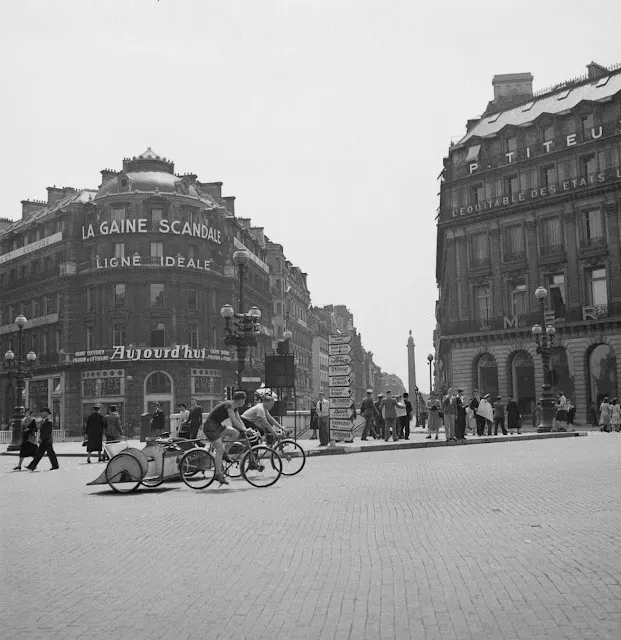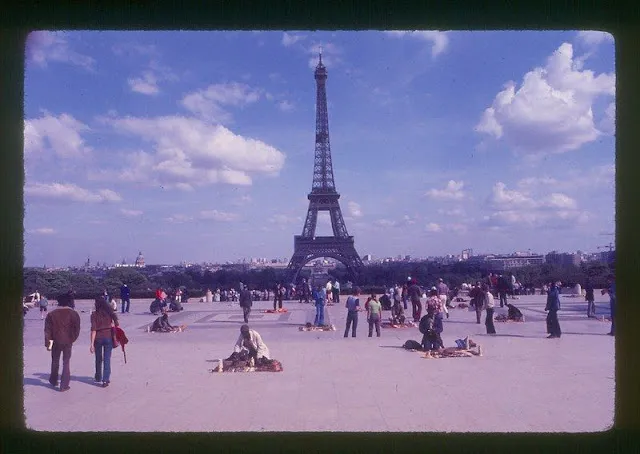After the austerity and bloodshed of World War I, France longed for joy and light-heartedness. Pre-war values were rejected as people embraced new lifestyles and new technologies, and discovered a lust for extravagance and partying that had the era named Les Années Folles (the Roaring Twenties, or the 'mad years'). Cars appeared on the roads; picture houses opened, projecting the world's first silent movies; radios appeared in households; jazz flourished, and musical halls – where icons like Josephine Baker and Maurice Chevalier launched their careers – became the places to see and be seen in.
Paris was at the heart of it all, not only in terms of fashion and entertainment, but in the domains of decorative art and architecture, as movers and thinkers drew inspiration from cubism, modernism and neoclassicism to create the 'total' style we know and love today: art deco. Such was the impact of this 'modern style' that it carried on well into the 1930s.

|
| A triporteurs race is shown passing under a backdrop of the Eiffel Tower in Paris, January 1920. (Keystone-france / Getty) |

|
| Two Parisian women enjoy an afternoon cup of coffee, circa 1925. (Branger / Roger Viollet / Getty Images) |

|
| The Eiffel Tower is shown peeking between the Parisian back streets. (Hulton Archive / Getty Images) |
 |
| Two women elegantly show off the fashions of their era. (Hulton Archive / Getty Images) |
 |
| Children are seen selling lilies in the streets of Paris, 1930. (Anonym / IMAGNO/Austrian Archives (S)) |
 |
| A couple enjoys a nice bottle of wine and a breathtaking view from the Eiffel Tower in 1928. (Keystone-france / Albert) |
 |
| A women sits comfortably in 1925 fashions: a jumper suit with contrasting trim, worn with a cloche hat with turned back brim. (Seeberger Freres / Getty Images) |
 |
| The Eiffel Tower as seen from the Trocadéro, circa 1925. (Seeberger Freres / Getty Images) |
 |
| Mlle Marie Simonne is seen with her friends after winning the “Pearly Queen of Paris” beauty pageant, August 1926. (Fox Photos / Getty Images) |
 |
| Cycling up the Champs Elysees are the nearly 160 competitors of the Tour de France in June, 1926. (Topical Press Agency / Getty Images) |
 |
| An ice-cream vendor selling sodas and sweets to children on the city streets, 1925. (Harlingue / Getty Images) |
 |
| American publisher Sylvia Beach stands in the doorway of her bookshop “Shakespeare & Company”, during the 1920s. The shop gained recognition for being run by the only person willing to publish James Joyce’s Ulysses in the English language and was regarded as a haven for American expatriates during the 1920s and 1930s. (Hulton Archive / Getty Images) |
 |
| A crowded bar is shown at La Boule Blanche, a much-frequented Paris nightclub of the era. (Sasha / Getty Images) |
 |
| Patrons have a drink and take a swim at the Champs Elysees Lido in Paris, circa 1925. (Henry Guttmann / Getty Images) |
 |
| A group of women celebrate a réveillon in Paris, circa 1925. A réveillon is a dinner party preceding Christmas and New Year, at which luxury foods and wines are often served. (Fpg / Getty Images) |
 |
| Members of the “Friday The Thirteenth Club” walk under a ladder in single file line at a meeting in a Paris bar. The club met every Friday 13th to do everything that superstitious people traditionally avoid. (Keystone / Getty Images) |
 |
| A Parisian bar is shown bustling after dark. (Keystone / Getty Images) |
 |
| “The Hoffman Girls” pose for a picture backstage before appearing at the Moulin Rouge in Paris, February 1924. (Topical Press Agency / Getty Images) |
 |
| Gardeners taking care of a tulip field in front of the Carrousel du Louvre, in spring 1929. (Keystone-france / Getty Images) |

|
| A little girl hands a posy of lilies to a police officer on duty at the Porte Saint-Denis in Paris, circa 1920. (Fpg / Getty Images) |



